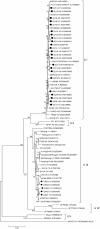Sero-Molecular Epidemiology of Japanese Encephalitis in Zhejiang, an Eastern Province of China
- PMID: 27560360
- PMCID: PMC4999095
- DOI: 10.1371/journal.pntd.0004936
Sero-Molecular Epidemiology of Japanese Encephalitis in Zhejiang, an Eastern Province of China
Abstract
Background: Sporadic Japanese encephalitis (JE) cases still have been reported in Zhejiang Province in recent years, and concerns about vaccine cross-protection and population-level immunity have been raised off and on within the public health sphere. Genotype I (GI) has replaced GIII as the dominant genotype in Asian countries during the past few decades, which caused considerable concerns about the potential change of epidemiology characteristics and the vaccine effectiveness. The aim of this study was to investigate the prevalence of JE neutralizing antibody and its waning antibody trend after live attenuated JE vaccine immunization. Additionally, this study analyzed the molecular characteristics of the E gene of Zhejiang Japanese encephalitis virus (JEV) strains, and established genetic relationships with other JEV strains.
Methodology/principal findings: A total of 570 serum specimens were sampled from community population aged from 0 to 92 years old in Xianju county of Zhejiang Province in 2013-2014. Microseroneutralization test results were analyzed to estimate the population immunity and to observe antibody dynamics in vaccinated children. E genes of 28 JEV strains isolated in Zhejiang Province were sequenced for phylogenetic tree construction and molecular characteristics analysis with other selected strains. Positive JE neutralizing antibody rates were higher in residents ≥35 years old (81%~98%) and lower in residents <35 years old (0~57%). 7 or 8 years after the 2nd live attenuated vaccine dose, the antibodies against for 4 different strains with microseroneutralization test were decreased by 55%~73% on seropositive rates and by 25%~38% on GMTs respectively. JEV strains isolated in recent years were all grouped into GI, while those isolated in the 1980s belonged to GIII. On important amino acid sites related to antigenicity, there was no divergence between the Zhejiang JE virus strains and the vaccine strain (SA14-14-2).
Conclusion/significances: JE neutralizing antibody positive rates increase in age ≥10 years old population, likely reflecting natural infection or natural boosting of immunity through exposure to wild virus. JE seropositivity rates were quite low in <35 years old age groups in Zhejiang Province. Waning of neutralizing antibody after live attenuated vaccine immunization was observed, but the clinical significance should be further investigated. Both the peripheral antibody response and genetic characterization indicate that current live attenuated JE vaccine conferred equal neutralizing potency against GI or GIII of wild strains. GI has replaced GIII as the dominant genotype in Zhejiang in the past few decades. Although the chance of exposure to wild JE virus has reduced, the virus still circulates in nature; therefore, it is necessary to implement immunization program for children continually and to conduct surveillance activity periodically.
Conflict of interest statement
The authors have declared that no competing interests exist.
Figures





Similar articles
-
Serological and molecular epidemiology of Japanese Encephalitis in Zhejiang, China, 2015-2018.PLoS Negl Trop Dis. 2020 Aug 27;14(8):e0008574. doi: 10.1371/journal.pntd.0008574. eCollection 2020 Aug. PLoS Negl Trop Dis. 2020. PMID: 32853274 Free PMC article.
-
Partial protective efficacy of the current licensed Japanese encephalitis live vaccine against the emerging genotype I Japanese encephalitis virus isolated from sheep.Front Immunol. 2025 Feb 13;16:1513261. doi: 10.3389/fimmu.2025.1513261. eCollection 2025. Front Immunol. 2025. PMID: 40018033 Free PMC article.
-
Low Protective Efficacy of the Current Japanese Encephalitis Vaccine against the Emerging Genotype 5 Japanese Encephalitis Virus.PLoS Negl Trop Dis. 2016 May 3;10(5):e0004686. doi: 10.1371/journal.pntd.0004686. eCollection 2016 May. PLoS Negl Trop Dis. 2016. PMID: 27139722 Free PMC article.
-
Japanese encephalitis vaccines: Immunogenicity, protective efficacy, effectiveness, and impact on the burden of disease.Hum Vaccin Immunother. 2017 Jun 3;13(6):1-18. doi: 10.1080/21645515.2017.1285472. Epub 2017 Feb 22. Hum Vaccin Immunother. 2017. PMID: 28301270 Free PMC article. Review.
-
[Progress in the research of phenotype and genotype of Japanese encephalitis virus in China].Bing Du Xue Bao. 2013 Jun;29(4):457-64. Bing Du Xue Bao. 2013. PMID: 23895014 Review. Chinese.
Cited by
-
Decreases in Both the Seroprevalence of Serum Antibodies and Seroprotection against Japanese Encephalitis Virus among Vaccinated Children.Virol Sin. 2019 Jun;34(3):243-252. doi: 10.1007/s12250-019-00099-z. Epub 2019 Mar 25. Virol Sin. 2019. PMID: 30911897 Free PMC article.
-
New strains of Japanese encephalitis virus circulating in Shanghai, China after a ten-year hiatus in local mosquito surveillance.Parasit Vectors. 2019 Jan 9;12(1):22. doi: 10.1186/s13071-018-3267-9. Parasit Vectors. 2019. PMID: 30626442 Free PMC article.
-
Low population Japanese encephalitis virus (JEV) seroprevalence in Udayapur district, Nepal, three years after a JE vaccination programme: A case for further catch up campaigns?PLoS Negl Trop Dis. 2019 Apr 15;13(4):e0007269. doi: 10.1371/journal.pntd.0007269. eCollection 2019 Apr. PLoS Negl Trop Dis. 2019. PMID: 30986252 Free PMC article.
-
Emerging West African Genotype Chikungunya Virus in Mosquito Virome.Virulence. 2025 Dec;16(1):2444686. doi: 10.1080/21505594.2024.2444686. Epub 2024 Dec 23. Virulence. 2025. PMID: 39715491 Free PMC article.
-
Economic and disease burden of Japanese encephalitis in Zhejiang Province, 2013-2018.PLoS Negl Trop Dis. 2021 Jun 21;15(6):e0009505. doi: 10.1371/journal.pntd.0009505. eCollection 2021 Jun. PLoS Negl Trop Dis. 2021. PMID: 34153039 Free PMC article.
References
-
- Uchil PD, Satchidanandam V (2001) Phylogenetic analysis of Japanese encephalitis virus: envelope gene based analysis reveals a fifth genotype, geographic clustering, and multiple introductions of the virus into the Indian subcontinent. Am J Trop Med Hyg 65: 242–251. - PubMed
-
- Williams DT, Wang LF, Daniels PW, Mackenzie JS (2000) Molecular characterization of the first Australian isolate of Japanese encephalitis virus, the FU strain. J Gen Virol 81: 2471–2480. - PubMed
Publication types
MeSH terms
Substances
LinkOut - more resources
Full Text Sources
Other Literature Sources
Miscellaneous

